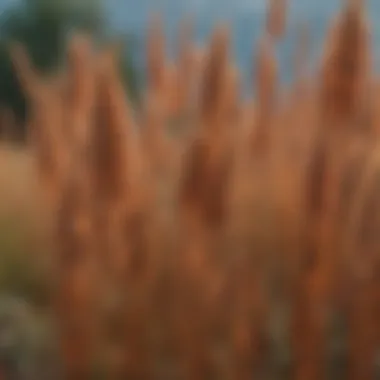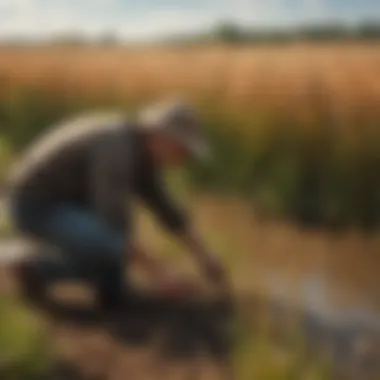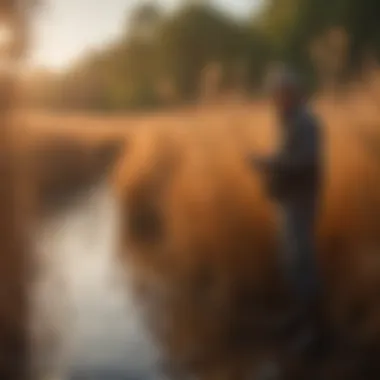Phragmites Seeds for Sale: Benefits and Considerations


Overview of the Topic
Definition and Importance
Phragmites, commonly known as common reed, is a perennial grass that thrives in wetland environments. The seeds of this plant are valuable for several ecological applications. Their ability to establish rapidly and grow in various conditions makes them important for erosion control and habitat restoration. In recent years, there has been increasing interest in the availability of phragmites seeds for sale, particularly among agricultural farmers and environmental enthusiasts. Understanding the benefits and considerations associated with these seeds is crucial for making informed decisions in land management and ecological restoration projects.
Current Trends
The market for phragmites seeds has been evolving. As awareness of environmental sustainability grows, more organizations and individuals seek to incorporate native plants into their landscape management practices. There’s a noticeable shift toward using phragmites as a means to improve biodiversity in wetland areas. Online suppliers are emerging, offering a variety of seeds that cater to the specific needs of different regions.
Benefits of Phragmites Seeds
The benefits of phragmites seeds span from ecological restoration to land management. Key advantages include:
- Erosion control: Phragmites establishes dense root systems that help stabilize soil in wetland areas.
- Habitat creation: These plants serve as crucial habitat for numerous wildlife species, promoting biodiversity in local ecosystems.
- Water purification: Phragmites can improve water quality by absorbing excess nutrients and pollutants.
- Carbon sequestration: The growth of phragmites aids in capturing carbon, contributing positively to climate change mitigation efforts.
"Utilizing phragmites seeds can significantly enhance the ecological quality of degraded lands, leading to more resilient landscapes."
Key Techniques and Practices
Step-by-Step Guide
To effectively utilize phragmites seeds, follow these steps:
- Identify the location: Choose an appropriate site with sufficient moisture and sunlight.
- Prepare the soil: Clear any debris and till the soil to create a suitable planting bed.
- Plant the seeds: Sow seeds during the late spring or early summer, ensuring they are spaced adequately to allow for growth.
- Water regularly: Maintain consistent moisture to support germination and establish growth.
- Monitor growth: Check for pests and diseases and ensure the plants are thriving.
Tools and Equipment Needed
A few essential items are needed for successful phragmites seed planting:
- Trowel or shovel for soil preparation
- Garden hose or irrigation system for watering
- Mulch to retain soil moisture
- Gloves to protect your hands during planting
Challenges and Solutions
Common Obstacles
While phragmites can be beneficial, there are challenges to consider as well:
- Invasive tendencies: In some regions, phragmites can become invasive, outcompeting native species.
- Water dependency: These plants require specific wetland conditions to thrive; unsuitable environments can hinder growth.
Innovative Solutions
To manage these challenges, implement the following strategies:
- Sustainable management practices: Regularly monitor plant growth and remove excess plants if they become invasive to maintain ecological balance.
- Environmental assessment: Evaluate the planting site conditions before introducing seeds to ensure they suit the needs of phragmites.
Understanding Phragmites
Understanding Phragmites is crucial for anyone involved in agricultural practices, land management, or ecological restoration. These tall, perennial grasses can play a significant role in various environmental functions. Furthermore, grasping their potential benefits and challenges is essential to optimize their usage. Knowledge of Phragmites helps landowners and practitioners enhance biodiversity, stabilize soils, and improve water management efforts.
Defining Phragmites: A Botanical Overview
Phragmites, commonly known as common reed, belongs to the Poaceae family. This genus features several species, with Phragmites australis being the most widely recognized. It can grow up to four meters tall, characterized by its feathery flower spikes that emerge from its top. This robust grass is typically found in wetlands, along riverbanks, and in disturbed areas, demonstrating remarkable adaptability.
One of the defining features of Phragmites is its extensive root system. This characteristic allows it to thrive in varying soil conditions while stabilizing sediments, offering potential erosion control. Moreover, Phragmites has a unique ability to filter pollutants from water, contributing to improved water quality in ecosystems.
Types of Phragmites and Their Characteristics
There are several varieties of Phragmites, each with distinct traits. Here are a few notable ones:
- Phragmites australis: This is the most common species, found in numerous habitats. It typically grows in dense stands, which makes it effective for habitat creation but can sometimes lead to invasiveness.
- Phragmites karka: This variety is native to Asia and Africa. It often thrives in drier conditions compared to its counterpart. Its growth form is less aggressive, making it suitable for certain restoration projects.
- Phragmites monksii: This less common type is distinguished by its shorter stature and finer stems. It can adapt well to sandy soils, offering versatility in cultivation.


The differences in these types play a significant role in their practical applications. Certain species are preferred for specific ecological functions, such as erosion control, while others are favored for ornamental landscaping.
The Importance of Phragmites in Ecosystems
Phragmites, commonly known as common reed, is a vital plant species for many ecosystems around the world. Its extensive root systems and tall, dense growth make it a crucial player in ecological stability. These plants not only provide tangible benefits for land management but also create essential habitats for diverse forms of wildlife. Understanding the importance of Phragmites is key to appreciating its role in water management, biodiversity, and habitats.
Role in Water Management and Soil Stabilization
Phragmites plays a significant role in managing water resources. The plant thrives in wetlands, marshes, and along riverbanks, helping to absorb excess water. This natural capability reduces flood risks by acting as a sponge that retains water during heavy rainfall. Moreover, the dense root structure of Phragmites aids in soil stabilization, effectively preventing soil erosion. This is particularly important in areas prone to flooding or heavy rains, where soil degradation can lead to significant environmental damage.
The plant also helps improve water quality. Phragmites can absorb nutrients and contaminants from the water, acting as a natural filtration system. This capability makes it valuable for ecological restoration projects where water quality is a concern. Implementing Phragmites in wetland restoration can thus enhance both water quality and ecological balance.
"Integrating Phragmites into land management practices leads to tangible benefits, particularly in water retention and improving soil integrity."
Contributions to Biodiversity and Habitat Creation
Phragmites directly contributes to biodiversity by providing habitat for various species. Birds, insects, and aquatic animals often rely on the dense stands of Phragmites for shelter and breeding grounds. For instance, many migratory birds use these vegetation areas for nesting, which indicates their significance in maintaining avian populations.
In addition, the plant supports various insects, including pollinators, thus promoting a balanced ecosystem. Its presence can improve the habitat's overall resilience to environmental stresses.
In habitat creation, Phragmites serves as a joining link in the food web. The plant offers food sources for herbivores, which in turn support predators. This interdependence illustrates the interconnectedness of ecosystems, highlighting why preserving Phragmites-rich environments is essential for sustaining local wildlife.
Overall, the ecological importance of Phragmites cannot be overstated. It is crucial for water management, acts as a stabilizing force for soils, and boosts biodiversity through habitat creation. Understanding these factors influences how Phragmites seeds are viewed, particularly in the context of land management and ecological conservation.
Market Availability of Phragmites Seeds
Understanding the market availability of Phragmites seeds is crucial for various stakeholders, from agricultural practitioners to environmental enthusiasts. The increasing interest in using Phragmites for ecological and land management purposes highlights the need to locate reliable sources for obtaining these seeds. It is vital to explore where to find them and what to consider when choosing vendors. Availability directly impacts the potential for successful planting and the subsequent benefits that Phragmites can offer, such as soil stabilization and ecological restoration.
Where to Find Phragmites Seeds for Sale
Access to Phragmites seeds is growing, with various suppliers offering them through different channels. Here are effective avenues to explore:
- Nurseries and Garden Centers: Local nurseries often carry native Phragmites seeds, especially if they focus on local ecosystems.
- Online Retailers: Websites like Amazon and specialized agricultural supply sites frequently stock Phragmites seeds. Ensure the vendor is reputable and sells high-quality seeds.
- Ecological Organizations: Some non-profits and conservation groups sell seeds, often with a focus on native species and local ecosystems.
- Local Agricultural Extensions: State agricultural extensions can provide information on where to purchase Phragmites seeds that are suitable for local conditions.
This varied availability allows buyers to choose sources that align with their sustainability goals and ecological needs.
Evaluating Seed Vendors: Key Considerations
Not all vendors are equal when it comes to selling Phragmites seeds, and selecting the right one requires careful evaluation. Here are essential factors to consider:
- Seed Quality: Look for vendors who provide information about seed purity, germination rates, and provenance. High-quality seeds contribute to better results in growth and establishment.
- Sustainability Practices: Choose vendors that follow sustainable practices in their seed sourcing and selling processes. This supports ecological balance and responsible cultivation.
- Customer Reviews: Check customer feedback and ratings for insights into a vendor's reliability and product quality. Reviews can highlight the experiences of other buyers.
- Regulatory Compliance: Make sure the vendor complies with local and federal regulations regarding native species. This ensures you are not inadvertently supporting the spread of invasive species.
"Evaluating vendors carefully can prevent problems down the line, ensuring successful growth and ecological integrity of your land."
Benefits of Purchasing Phragmites Seeds
The act of purchasing Phragmites seeds can enhance land management strategies significantly. These seeds play a crucial role in environmental sustainability, offering various benefits in different contexts. Understanding these advantages can assist farmers and enthusiasts in making informed decisions about their use.
Enhancing Land Rehabilitation Efforts
Phragmites, particularly the common species known as Phragmites australis, has become a staple in land rehabilitation projects. Its robust growth and resilience make it an ideal choice for restoring degraded areas. In stronger terms, this grass can stabilize soil, reduce erosion, and improve water quality. When planted in areas affected by pollution or degradation, Phragmites helps filter contaminants, thus enhancing overall ecosystem health.
Land rehabilitation efforts often require vegetation that can establish quickly and thrive in challenging conditions. Phragmites seeds offer this adaptability, allowing for reestablishment of habitats crucial for various wildlife species. Importantly, using native Phragmites can aid in the restoration of ecological balance, promoting biodiversity in the affected areas.
Some additional factors worth considering include:
- Rapid Growth: Phragmites can establish a strong root system within weeks, making it ideal for quick interventions.
- Cost-effective: Compared to other restoration efforts, using well-sourced Phragmites seeds can reduce costs significantly.
- Wildlife Habitat: Its dense growth provides refuge and breeding grounds for numerous bird species and other wildlife, thus supporting local biodiversity.
Potential for Use in Bioengineering Projects
Bioengineering projects have increasingly recognized the utility of Phragmites seeds. These projects often intersect with environmental engineering, landscape architecture, and habitat design. Phragmites’ extensive root systems improve soil aeration and stability, which is vital in creating sustainable landscapes that cater to both human and ecological needs.
The incorporation of Phragmites in bioengineering can lead to:


- Green Infrastructure: Phragmites can be utilized in the creation of wetlands or green roofs, contributing to urban greening and stormwater management.
- Natural Barriers: Its growth can serve as a natural barrier against wind and water erosion, protecting vulnerable landscapes from further degradation.
- Water Treatment: Its ability to absorb nutrients and pollutants makes Phragmites an effective tool for wastewater treatment systems, contributing to cleaner waterways.
As a result, buyers should consider the diverse applications of Phragmites seeds in their projects, encouraging practices that support sustainability. Investing in these seeds is not just an act of planting; it promotes responsible stewardship of the land, yielding benefits that can be measured in terms of ecological restoration and public well-being.
"Investing in Phragmites seeds is not simply about vegetation; it’s about enhancing ecosystems, managing landscapes, and creating sustainable futures."
Considerations Before Buying Phragmites Seeds
When considering the purchase of Phragmites seeds, several factors come into play. Proper evaluation of local regulations and species compatibility is crucial. Not only do these elements impact the effectiveness of growth, but they also inform environmental sustainability and local ecosystems. Understanding what to look for can make a significant difference between a successful project and potential ecological imbalance.
Having this knowledge sets a foundation for responsible practices. Buyers must inform themselves thoroughly about the implications of introducing Phragmites into their landscapes.
Local Regulations and Environmental Impact
Before acquiring Phragmites seeds, one must navigate the complex landscape of local regulations. Different regions have varying laws concerning the planting of non-native species, which can be critical for maintaining ecosystem balance. Ignoring these regulations could lead to legal issues or harm local biodiversity.
Phragmites australis, for instance, is known for its vigor and ability to dominate spaces quickly. This characteristic may be beneficial in some contexts but potentially harmful in others. If local flora struggles due to competition, significant changes to the ecosystem could result.
It is essential to consult local environmental agencies or extension offices. They offer guidelines on whether Phragmites is suitable for your area and how to cultivate it responsibly.
Regulatory compliance strengthens not only your project but also contributes positively to the environment.
Species Compatibility and Invasiveness
Another key consideration is the compatibility of Phragmites species with local flora. Using native varieties can enhance ecological integration and minimize invasive risks. Researching the specific Phragmites species suitable for your region is essential.
Phragmites seeds are not all equal; some species thrive better in certain conditions than others. Moreover, while the common reed might seem advantageous for projects such as erosion control, it can easily become invasive if not managed properly.
Here are important points to consider:
- Understand local ecosystems. Knowing what species coexist will help in making informed decisions.
- Evaluate potential invasiveness. Assess whether the selected variety poses a threat to surrounding plant life.
- Consider long-term impacts. Think about how established Phragmites populations may alter local biodiversity over time.
Always prioritize compatibility over convenience in selecting Phragmites seeds. Your choices have lasting effects on the natural landscape.
Pricing Structures for Phragmites Seeds
Understanding the pricing structures for Phragmites seeds is critical for anyone interested in cultivating these plants. The cost varies significantly based on several factors, impacting the decision-making process for farmers and land managers. By grasping how these elements interplay, it becomes possible to make informed purchases, ultimately aiding in effective land management.
Factors Influencing Seed Prices
There are several key factors that can influence the price of Phragmites seeds. These include:
- Seed Quality: High-quality seeds often come with a higher price tag. The genetic purity and germination rates can be essential for successful growth.
- Vendor Reputation: Established companies that specialize in seed production typically charge more due to their investment in quality control and customer service.
- Region of Sale: The geographical area can also affect the price. Local suppliers may have lower prices due to reduced shipping costs compared to those shipping from distant locations.
- Market Demand: Increased interest in Phragmites for ecological restoration, erosion control, or other environmental projects can lead to price surges.
- Packaging Size: Seeds sold in bulk packages tend to offer a lower cost per seed compared to smaller retail units. Buying larger quantities can be more economical, especially for large-scale projects.
By considering these elements, potential buyers can better navigate the market and select options that provide the best value.
Understanding Bulk Purchase Options
Bulk purchasing offers significant advantages when it comes to acquiring Phragmites seeds. Understanding these options can lead to cost savings and enhanced project efficiency. Here are some important points to consider:
- Cost Efficiency: Buying seeds in bulk often reduces the price per unit, making it an attractive option for extensive projects.
- Customization: Some suppliers may offer tailored packages for specific needs, helping buyers get the exact variety and quantity required for their projects.
- Sustainability Practices: Greater quantities of seeds can support larger planting initiatives aligned with ecological restoration efforts. This practice can contribute positively to environmental management.
- Long-Term Supply: Bulk purchases allow for consistent access to seeds over an extended period, which is valuable for ongoing or repeat projects.
Exploring options for bulk seed purchases can lead to a practical and economical approach to Phragmites cultivation.
Having a clear understanding of pricing structures and the factors influencing these costs is essential for any agricultural project involving Phragmites.
Sustainable Practices in Phragmites Cultivation
Sustainable practices in phragmites cultivation are vital for ensuring that this species is used effectively and responsibly within ecosystems. As phragmites play significant roles in water management and habitat creation, adopting sustainable techniques can enhance these benefits while minimizing negative impacts on local environments. Understanding how to cultivate phragmites sustainably can lead to improved ecological health and better outcomes for land management projects.
Developing a sustainable approach involves multiple facets, such as selecting the right species, managing growth, and understanding the environmental impacts. When farmers and land stewards engage in these practices, they benefit not only their land but also contribute positively to the surrounding ecosystem.


Best Practices for Cultivating Phragmites
When considering the cultivation of phragmites, it is essential to adopt specific best practices. These can include:
- Site Preparation: Prepare the area where phragmites will be grown by ensuring proper soil conditions that support growth. Ensure that the soil is well-drained and has the right pH level.
- Seed Quality: Use high-quality seeds from reputable vendors. This ensures better germination rates and healthier plants.
- Planting Techniques: Plant seeds or plugs during the optimal growing season. This usually occurs in the early spring or fall. Ensure adequate spacing between plants to avoid overcrowding.
- Irrigation: Monitor water levels and ensure consistent moisture, especially during the first growing season. Phragmites thrive in wet conditions but can suffer from drought.
- Minimal Disturbance: Avoid disturbing the surrounding area during growth. Preserving the habitat allows for better biodiversity around the cultivation site.
By following these practices, cultivators can promote healthy growth while supporting local ecology.
Monitoring and Managing Growth Effectively
Monitoring and managing growth is crucial to successful phragmites cultivation. Regular assessment can help identify any potential issues, such as pest infestations or nutrient deficiencies. Key strategies for effective management include:
- Regular Inspection: Routinely check the health of the plants. Look for signs of stress or disease early on to take action promptly.
- Nutrient Levels: Conduct soil tests to determine nutrient levels. Applying organic fertilizers can improve soil health and support robust growth.
- Water Management: Pay attention to water levels, especially if the cultivated area experiences heavy rainfall or drought.
- Control Measures: Should invasive species or pests become an issue, implement control measures that are safe for the environment. Consider using barriers or natural predators as alternatives to chemical treatments.
Effective management of phragmites not only ensures a healthy population but also aids in their ecological purpose, such as water filtration and habitat creation.
By instilling sustainable practices in phragmites cultivation, individuals can participate in building a more resilient environment. With proper attention to detail, phragmites can thrive while supporting larger ecological goals.
Future Trends in Phragmites Cultivation
The future of Phragmites cultivation holds significnt potential, shaped by advances in technology and a growing recognition of its ecological importance. As agricultural and environmental sectors converge, there is an increasing demand for sustainable practices. Phragmites, with its robust adaptability, is becoming a favored choice in restoration efforts, wetland management, and erosion control systems. This section will elaborate on emerging trends that underscore its relevance and application in modern agricultural contexts.
Advancements in Ecological Applications
Innovative applications are being developed to make Phragmites a cornerstone of ecological engineering. One crucial advancement is its use in bioremediation. Phragmites can process and absorb pollutants, making it effective in purifying water and restoring contaminated sites. For instance, this species is pivotal in constructed wetlands, where it enhances water quality by filtering and breaking down harmful substances.
Moreover, enhancing biodiversity in managed landscapes is another focus area. Phragmites can be integrated into habitat restoration projects to support native wildlife. This not only helps in the establishment of new ecosystems but also creates corridors for species migration. In agricultural settings, Phragmites are being used to handle runoff and improve soil health, which can beneficially affect crop yields.
Benefits of these advancements include:
- Improved ecosystem services
- Enhanced soil stability
- Better water quality
These ecological benefits further highlight the need for responsible cultivation and management practices within the Phragmites industry.
Research and Development Opportunities
As the demand for sustainable agricultural practices grows, research into Phragmites cultivation is becoming essential. Several universities and research institutions are exploring genetic traits that may enhance the plant's resilience to climate variability and its efficiency in resource use. For example, studies on drought-resistant varieties could revolutionize how this plant contributes to land rehabilitation in marginalized environments.
Additionally, technological innovations such as precision agriculture are beginning to be applied to Phragmites farming. Tools like drones and satellite imagery can be used to monitor growth and health of the crops, providing farmers with real-time data for better management decisions.
Potential research areas include:
- Genetic modification for enhanced performance
- Eco-friendly pest management strategies
- Sustainable harvesting methods
Investing in Phragmites research can foster collaboration across disciplines. When different sectors focus on plant cultivation processes, the overall understanding of its applications improves.
"Innovation in Phragmites growing practices can lead to answers for some of the pressing environmental challenges we face today."
Thus, the future of Phragmites cultivation seems promising. As we explore these advancements, it is vital that all stakeholders remain committed to environmental stewardship and apply best practices at every level.
Finale and Further Reading
Understanding the dynamics surrounding Phragmites seeds is crucial for those interested in agriculture, ecology, and land management. This article has explored various dimensions of Phragmites cultivation, emphasizing the seeds' availability in the market, their benefits, and essential considerations before purchase. This topic serves not only as a guide for responsible buying practices but also as an invitation to engage in sustainable environmental stewardship. Through informed decisions, individuals and organizations can contribute to water management, soil stabilization, and enhanced biodiversity in their regions.
Summarizing Key Insights on Phragmites Seeds
Throughout this article, we highlighted several key points regarding Phragmites seeds:
- Market Availability: Seeds can be found from various vendors, but careful evaluation is necessary to ensure quality.
- Ecological Benefits: The correct use of Phragmites can improve land rehabilitation and support bioengineering projects.
- Considerations for Buyers: Local regulations and species compatibility are critical factors to ponder before committing to a purchase.
- Sustainable Practices: Implementing best practices in cultivation can enhance the successful growth of Phragmites while protecting surrounding ecosystems.
A thorough comprehension of these aspects will enable potential buyers to make educated choices and contribute positively to their environments.
Recommended Resources for Continued Learning
To expand your knowledge of Phragmites seeds and their applications, consider utilizing the following resources:
- Wikipedia - Phragmites
- Britannica - Phragmites
- Reddit - Urban Agriculture for community discussions and personal insights.
- Follow knowledgeable entities on social media platforms, like Facebook, to stay updated on trends in agriculture.
Utilizing these resources will not only enhance your understanding but also open avenues for further exploration into the ecological and practical aspects of Phragmites cultivation.



